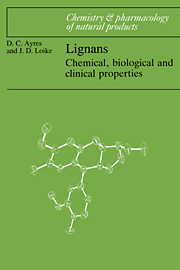Book contents
- Frontmatter
- Contents
- To students and colleagues in Westfield College, 1965–1984.
- Preface
- Glossary for lignans
- 1 Introduction
- 2 A registry of the natural lignans
- 3 Biological and clinical properties of podophyllotoxin and other lignans
- 4 Etoposide and Teniposide
- 5 Isolation, purification and initial characterisation
- 6 Determination of structure
- 7 Biosynthesis
- 8 Synthesis
- Botanical index
- General index
5 - Isolation, purification and initial characterisation
Published online by Cambridge University Press: 05 February 2012
- Frontmatter
- Contents
- To students and colleagues in Westfield College, 1965–1984.
- Preface
- Glossary for lignans
- 1 Introduction
- 2 A registry of the natural lignans
- 3 Biological and clinical properties of podophyllotoxin and other lignans
- 4 Etoposide and Teniposide
- 5 Isolation, purification and initial characterisation
- 6 Determination of structure
- 7 Biosynthesis
- 8 Synthesis
- Botanical index
- General index
Summary
Lignans (Whiting, 1987; Chatterjeee et al., 1984) occur typically in vascular plants (Hearon and MacGregor, 1955) and are found in roots and rhizomes and the woody parts, stems, leaves, seeds and fruits. In primitive species, such as those of the Podophyllaceae, they are the principal organic inclusions. With a few notable exceptions these sources do not provide commercially useful quantities. However, the wound resins of trees are a valuable major source of lignans, which here occur in simple mixtures with other natural products and are readily separated in substantial quantities (Table 5.1).
This review has been subdivided on the basis of parts of plants as sources because this is still the approach most often taken by chemists. It is unfortunate that relatively few studies have been made on the variations of inclusion compounds between the parts of whole plants.
Plant root sources
The roots and rhizomes of Podophyllum plants yield up to ten individual aryltetralins (Jackson and Dewick, 1985) which may also be found as their glycosidic variants. The flavones quercetin and rhamnetin are the only other identified products (Hartwell and Schrecker, 1958).
The roots and rhizomes of Podophyllum hexandrum afford commercially useful quantities of podophyllotoxin (2.357) with yields in the range of 1.5–4.0% of the dry weight (Hartwell and Schrecker, 1958). This will depend on the age of the plant but those which have come to maturity produce the lignan more economically than any existing laboratory synthesis. The American May apple, Podophyllum peltatum produces commercial quantities of podophyllotoxin and also of α-peltatin (2.354) and β-peltatin (2.355).
- Type
- Chapter
- Information
- LignansChemical, Biological and Clinical Properties, pp. 138 - 165Publisher: Cambridge University PressPrint publication year: 1990
- 1
- Cited by



